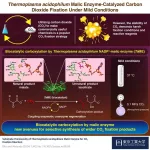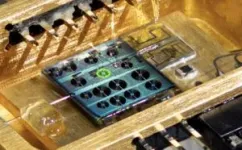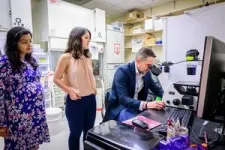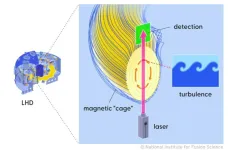(Press-News.org)
Carbon capture and utilization technologies for the conversion of carbon dioxide into carboxylic acids have garnered attention recently, with researchers from Tokyo Tech recently demonstrating a biocatalyzed carboxylation reaction of not only natural substrate, pyruvate, but also unnatural one, 2-ketoglutarate, using Thermoplasma acidophilum NADP+- malic enzyme under mild reaction conditions. The proposed strategy can be tailored for the selective synthesis through carbon dioxide fixation reactions.
Removing the excess carbon dioxide (CO2) from the environment is not the end goal of the decarbonization process necessary to reduce the effects of global warming caused by the greenhouse gas. Rather, novel carbon capture and utilization (CCU) technologies are gaining popularity in the current decade as an effective method for removing CO2 from the environment and transforming it into something valuable, for instance, commercially used chemicals such as carboxylic acids.
However, the stability of CO2 makes it unreactive and therefore a difficult starting material for carboxylic acid production. Thus, the resulting carboxylation procedure requires reactive reagents, high temperature and pressure conditions which significantly impact the process's energy cost and sustainability.
To overcome these issues, researchers Associate Professor Tomoko Matsuda and master student Yuri Oku, both from the Department of Life Science and Technology at Tokyo Institute of Technology (Tokyo Tech), explored the use of biocatalysts for CO2 fixation reactions. The findings of their study were published online in JACS Au on May 13, 2024. The researchers investigated and performed a carboxylation reaction under mild conditions in the presence of biocatalyst Thermoplasma acidophilum NADP+- malic enzyme (TaME) and gaseous CO2 via coupling enzymatic coenzyme regeneration. The proposed strategy accomplished the carboxylation reaction of not only a natural substrate pyruvate but also an unnatural substrate 2-ketoglutarate.
“The objective of our study was to develop a TaME-catalyzed carboxylation reaction using only gaseous CO2 as a CO2 source and to widen the substrate specificity of TaME for carboxylation,” remarks Matsuda. For the carboxylation reaction, the researchers chose TaME as the enzyme hoping for robustness and ease of handling, similar to other enzymes from T. acidophilum, which were also reported to have high thermal and CO2-pressure stabilities.
For carboxylation of pyruvate, it was treated with TaME and co-enzyme NADPH under 0.1 MPa pressure of CO2. This, however, led to a relatively lower yield. To solve this issue, the researchers added two new co-factors, namely TaGDH (GDH: glucose dehydrogenase) and D-glucose, which resulted in an 18-fold increase in the yield. They also studied the effects of CO2 pressure, pH, and substrate concentration on the carboxylation reaction. Furthermore, they successfully carried out reductive carboxylation of unnatural substrate, 2-ketoglutarate, to the corresponding product isocitrate by gaseous CO2, TaME, and TaGDH and D-glucose.
The biocatalyst-driven strategy proposed in this study led to successful carboxylation of natural substrate, pyruvate, and unnatural one, 2-ketoglutarate, under mild temperature (37 °C) and pressure conditions (0.1 MPa CO2), thus, lowering the energy burden and increasing the sustainability of the entire CCU process. The effective use of TaME has opened new avenues for selective synthesis of wider carboxylation products using safer and more environmentally friendly reagents instead of harsh chemicals.
“We believe that our proposed method can be re-engineered to perform a wide range of selective carboxylation reactions using renewable resources, under milder reaction conditions, and with less unwanted by-products and waste, unlocking the possibility of biocatalysis for the utilization of carbon dioxide as a starting material.” concludes Matsuda.
###
Related Links
For a greener, safer synthetic chemistry | Tokyo Tech story
https://www.titech.ac.jp/english/public-relations/prospective-students/first-step/matsuda-lab
Matsuda Research Group
https://www.matsuda.bio.titech.ac.jp/index(English).html
About Tokyo Institute of Technology
Tokyo Tech stands at the forefront of research and higher education as the leading university for science and technology in Japan. Tokyo Tech researchers excel in fields ranging from materials science to biology, computer science, and physics. Founded in 1881, Tokyo Tech hosts over 10,000 undergraduate and graduate students per year, who develop into scientific leaders and some of the most sought-after engineers in industry. Embodying the Japanese philosophy of “monotsukuri,” meaning “technical ingenuity and innovation,” the Tokyo Tech community strives to contribute to society through high-impact research.
https://www.titech.ac.jp/english/
END
Among US veterans diagnosed with lung cancer through the Veterans Health Administration healthcare system, those who underwent screening before diagnosis were more likely to be diagnosed with earlier stage disease and had a higher cure rate than those who had not been screened. The findings come from an observational study published by Wiley online in CANCER, a peer-reviewed journal of the American Cancer Society.
Lung cancer is the leading cause of cancer deaths worldwide, and most patients are diagnosed at ...
Peer-reviewed – Observational study - People
Adolescents who experience higher levels of social anxiety symptoms are more likely to report increased suicidal thoughts and other depressive symptoms two years later, according to new research.
The University of East Anglia-led study sheds light on the pressing need for early interventions to address society anxiety in young people.
Lead author Dr Kenny Chiu, Clinical Lecturer in Clinical Psychology at UEA’s Department of Clinical Psychology and Psychological Therapies, said: “Social Anxiety Disorder ...
Abnormal blood flow in the aorta is linked to inflammation and breakdown of the vessel wall in conditions where the aorta is dilated. This is shown in a study led by researchers at Linköping University. The findings can contribute to better diagnosis and open up new ways to assess the risk of serious and usually fatal complications, such as rupture of the aorta.
All blood in the body passes through the heart about once a minute. With every heartbeat, blood from the heart is pumped up into the aorta.
Dilation can occur in all parts ...
Health services should teach patients with eating disorders psychosocial skills to help more people recover and avoid relapse, according to an expert.
Anorexia, bulimia and other eating issues affect millions of people, and eating disorder specialist Bethany Crowley warns that eating disorders are often misunderstood. She suggests a more integrated approach to treating people is needed, to focus on the whole person rather than just the disordered eating.
Quieting negative thoughts, learning to cope with emotional triggers and practicing self-compassion are among nine key skills outlined by the therapist in a new book.
An Integrative Approach to Treating Eating ...
Background
Fusion energy is that released when two light nuclei combine to form a single heavier one (nuclear fusion reaction). Fusion energy-based power generation (fusion power plant) uses the energy generated when deuterium and tritium combine to form helium. A nuclear fusion reaction does not produce carbon dioxide. In addition, since it is possible to extract deuterium and tritium from the sea water, fusion energy is regarded as a sustainable energy source, and research into its practical application has been progressing rapidly ...
A glowing marker dye that sticks to prostate cancer cells could help surgeons to remove them in real-time, according to a study funded by Cancer Research UK.
Cancer Research UK-funded scientists, based at the Nuffield Department of Surgical Sciences and the Department of Oncology, University of Oxford, Oxford University Hospitals and Oxford NIHR Biomedical Research Centre used a fluorescent dye attached to a special marker molecule to give medics a “second pair of eyes” during surgery for prostate cancer.
Twenty-three men with prostate cancer were injected with the marker dye before undergoing prostate removal surgery. The marker dye found areas of cancerous tissue ...
ALS patients received better care if they were treated by a neurologist, a new study published in PLOS One has found.
But researchers found that Black, older and socially disadvantaged ALS patients were less likely to see a neurologist, raising concerns about equity in treating the deadly disease.
Patients who were treated by neurologists were more likely to receive interventions endorsed by the American Academy of Neurology.
“This study highlights the importance of neurologist care for ALS patients and the need to overcome barriers and provide care that is more equitable for ALS patients,” ...
College Park, Md. – Most people use Google Street View to find their way. Dr. Quynh Nguyen, an epidemiologist and statistician at the University of Maryland School of Public Health, uses it to locate spots where your journey might abruptly end. In a study published June 6 in the British Medical Journal (BMJ) of Injury Prevention, Nguyen identifies uses AI tools to identify key environmental elements impacting car-related collisions as well as cyclist-related and pedestrian-related accidents.
“Car crashes are the leading cause of death for young people ...
Researchers at the University of Michigan are finding that many patients may be encountering significant barriers to cancer care, even from their first phone call to a clinic.
Patients attempting to access cancer care must go through several different levels of communication, both before their initial appointment with a physician and throughout their treatment.
Making those first calls to learn more about available cancer care services or to schedule an appointment at a clinic is an important step toward beginning their treatment journey.
“Racial and ethnic disparities have been observed in the outpatient visit rates for ...
As the electric vehicle market booms, the demand for lithium — the mineral required for lithium-ion batteries — has also soared. Global lithium production has more than tripled in the last decade. But current methods of extracting lithium from rock ores or brines are slow and come with high energy demands and environmental costs. They also require sources of lithium which are incredibly concentrated to begin with and are only found in a few countries.
Now, researchers at the University of Chicago Pritzker School of Molecular Engineering (PME) have optimized a new method for extracting lithium from more dilute — and widespread — sources of the mineral, including seawater, ...





